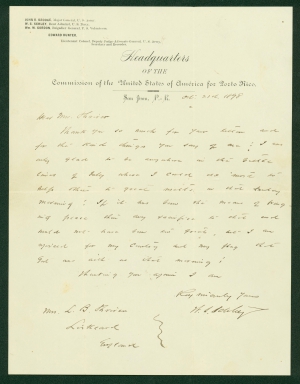Rear Admiral Schley on his Recent Victory over
the Spanish Fleet in the Battle of Santiago Bay |
Click to enlarge:

“If it has been the means of bringing peace then my sacrifice to that end would not have been too great.”
WINFIELD SCOTT SCHLEY.
Autograph Letter Signed to Mrs. L. B. Shriver. San Juan, P.R., October 21, 1898. 1 p., 8 x 10½ in. On “
Headquarters Army of the Commission of the United States of America for Porto Rico” stationery.
Inventory #21615
Price: $1,500
Partial Draft Transcript:
“Thank you so much for your letter and for the kind things you say of me. I was only glad to be anywhere in the battle lines of July where I could do most to help others to great results in that Sunday morning! If it has been the means of bringing peace then my sacrifice to that end would not have been too great, but I am rejoiced for my country and my flag that God was with us that morning!...”
Historical Background
Four months earlier, during the Spanish American War, Spain’s Admiral Pasqual Cervera and six of his ships had stopped for coal at Santiago on Cuba’s southern coast. Acting Rear Admiral William T. Sampson’s North Atlantic Fleet then blockaded the harbor. On Sunday morning, July 3, 1898, Sampson and two ships of his command left their positions in Santiago Bay for a short trip eastward to Siboney, Cuba, to meet with Major General William Shafter of the U.S. Army. With Sampson’s departure, Commodore Winfield S. Schley aboard the “Brooklyn” was now in command. Within an hour of Sampson’s departure, Admiral Cervera and his fleet tried to leave Santiago, breaking the blockade, but the remaining U.S. fleet, led by Schley, destroyed all of Cervera’s vessels without losing a single ship and with only one casualty, a yeoman on the “Brooklyn.” Spain had 350 dead and 160 wounded. Sampson, on his way to Siboney, heard the gunfire, had his ship, the “New York,” turned around, and returned to Santiago, but by then, the Battle of Santiago Bay was over. Sampson reported to Washington, “The fleet under my command offers the nation as a Fourth of July present the whole of Cervera’s fleet.” The July 4, 1898 edition of “The New York Times” headlined “Spanish Fleet Destroyed / Sampson’s Fourth of July Victory.” The next day, the “Times” published details of the victory with a subhead “Fighting Directed by Schley.” Sampson’s report of the victory did not even mention Schley’s name. In a July 8th editorial, reviewing the events in Santiago Bay, “The New York Times” concluded “Honor and praise in full measure are due both these gallant officers. The country is proud of them. Let Congress reward them both.”
On August 12, 1898, the Department of the Navy announced the promotions of both Sampson and Schley to Rear Admiral “for eminent and conspicuous conduct in battle.” That same day, a peace protocol ending all hostilities between Spain and the United States in Cuba, Puerto Rico, and the Philippines was signed in Washington, D.C.
In October, a report made by the navigating officers of the vessels participating in the Battle of Santiago Bay showed that Schley took part and that Sampson was nine miles away at the moment of victory. Later that month, on October 19, 1898, Rear Admiral Schley was placed in command of the naval station in San Juan, Puerto Rico. Two days later, he wrote this letter thanking an English admirer, and, referring to the Battle of Santiago Bay, admits that he was “glad to be anywhere in the battle lines of July…that Sunday morning” and that he “rejoiced for my country and my flag that God was with us that morning!”
Spanish American War letters are extremely rare. This one, penned by a major military leader, is especially desirable.